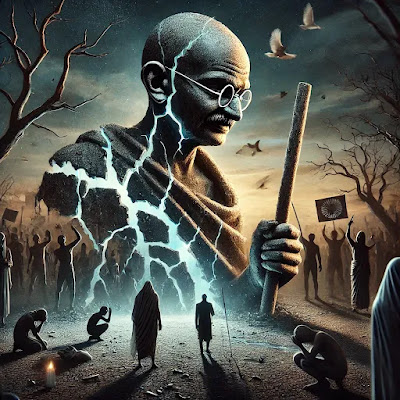Mohandas Karamchand
Hello everyone this blog is based on a thinking activity task based on I.A Richards “Practical Criticism”, which was assigned by Head of the Dept, Dr. Dilip Barad sir for further reading Click Here
I.A. Richards, in his "Practical Criticism" (1929), is one of the seminal works in literary theory, which focuses on close reading and analysis of the text without any extratextual context. He carried out experiments where he showed poems to students without mentioning the authors or backgrounds so that they would judge purely based on the text. This method was used to remove preconceptions and prejudices and promote more objective and disciplined approaches toward literary criticism. He brought the "Four Kinds of Meaning": sense, feeling, tone, and intention to take apart the ways language could mean and evoke.
New Criticism movement that emphasized an intrinsic examination of literary works which were in turn based on how a text is perceived and understood inside its covers rather than extra-textual factors like authors' intentions or historical surroundings.
As part of that, a contemporary poem was given by sir to analyze how to understand without connecting Factors like Society, Historical events, Name of Author, and also described what is problematic and misunderstanding.
Mohandas Karamchand
“Generations to come will scarcely
believe that such a one as this walked
the earth in flesh and blood.”
—Albert Einstein
Who? Who? Who?
Mahatma. Sorry no.
Truth. Non-violence.
Stop it. Enough taboo.
You need a thorough review.
Your tax-free salt stimulated our wounds
We gonna sue you, the Congress shoe.
Gone half-cuckoo, you called us names,
You dubbed us pariahs—“Harijans”
goody-goody guys of a bigot god
Ram Ram Hey Ram—boo.
Don’t ever act like a holy saint.
we can see through you, impure you.
Remember, how you dealt with your poor wife.
But, they wrote your books, they made your life.
They stuffed you up, the imposter true.
And sew you up—filled you with virtue
and gave you all that glossy deeds
enough reason we still lick you.
You knew, you bloody well knew,
Caste won’t go, they wouldn’t let it go.
It haunts us now, the way you do
with a spooky stick, a eerie laugh or two.
But they killed you, the naked you,
your blood with mud was gooey goo.
Sadist fool, you killed your body
many times before this too.
Bapu, bapu, you big fraud, we hate you.
First imagery of poem:
When I read this poem at first I'm confused about what the speaker actually wanted to say: is she in favor of Gandhi or criticizing him? Reading further I solved my confusion, Poem is about critiquing Gandhiji by Dalit people and the title itself was highlighting disrespect of Gandhiji.
Problematic Words and lines:
1)‘Enough taboo’, ‘gooey goo’, I searched these words but I can't understand what I choose.
2) ‘goody-goody guys of a bigot god
Ram Ram Hey Ram—boo.’ (lines from 3rd stanza)
‘It haunts us now, the way you do
with a spooky stick, a eerie laugh or two.’
(lines from 6th stanza) I can't get the real meaning of these lines which are appropriate to the poem.
Summary:
It paints a picture of Gandhi as an imperfect and impure person who perpetuated casteism, mistreated his wife, and was nothing more than a false icon of sainthood conjured up by others. The speaker criticizes the worship of Gandhi, pointing out unsolved social issues such as caste oppression and ridiculing his commitment to non-violence and truth. The tone oscillates between disdain and anger, finally culminating in outright hatred for Gandhi.
Analysis:
#Sense:- The poem expresses a profound disillusionment with Gandhi and his legacy. The imagery is raw and visceral, using metaphors like "tax-free salt stimulated our wounds" to critique his symbolic acts, like the Salt March, as insufficient and even harmful. The repetition of phrases like "you knew" emphasizes a betrayal, suggesting Gandhi was aware of the systemic injustices yet failed to address them adequately.
#Feeling:- The poem is the mix of emotions like anger, frustration, and betrayal. While the speaker seems to take up the voices of marginalized people by Gandhi's act or omission, he takes up the issues of caste and the controversial aspects of his personal life.
#Tone:- The tone is mocking of The saintly image of Gandhi stripped bare and all his faults are brutally revealed. Satirical elements come through lines like "Ram Ram Hey Ram—boo," where the iconic moments and symbols of Gandhi are mocked.
#Intention:- To deconstruct Gandhi’s legacy: It seeks to challenge the glorified narrative surrounding Gandhi, highlighting his contradictions and failures. To provoke critical reflection: This poem demands an assessment of what Gandhi truly achieved and how his acts affected the oppressed by unveiling the persistence of caste oppression and other unresolved issues.
Metaphors used in poem:
1)“Your tax-free salt stimulated our wounds”- The symbolic act of the Salt March is likened to rubbing salt into wounds, implying that it aggravated existing issues rather than healing them.
2)“Spooky stick, a eerie laugh or two”-Gandhi’s iconic walking stick and his perceived legacy are turned into haunting images, portraying him as a ghostly figure whose influence persists in a troubling way.
3)“Stuffed you up, the imposter true”- Implies that his image as a saint was manufactured rather than genuine.
4)“Caste won’t go, they wouldn’t let it go”- it was Emphasizes the enduring nature of systemic inequality and questions Gandhi’s efficacy in addressing it.
References:






No comments:
Post a Comment